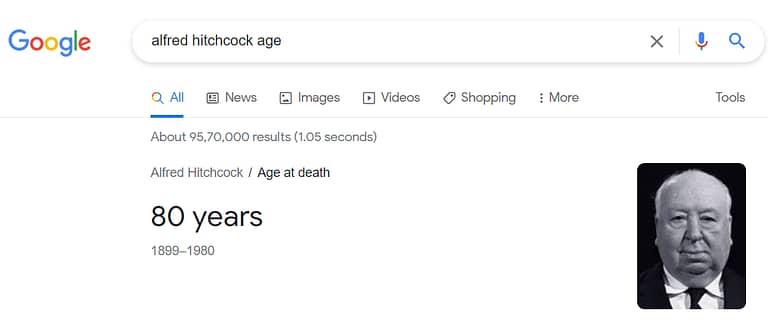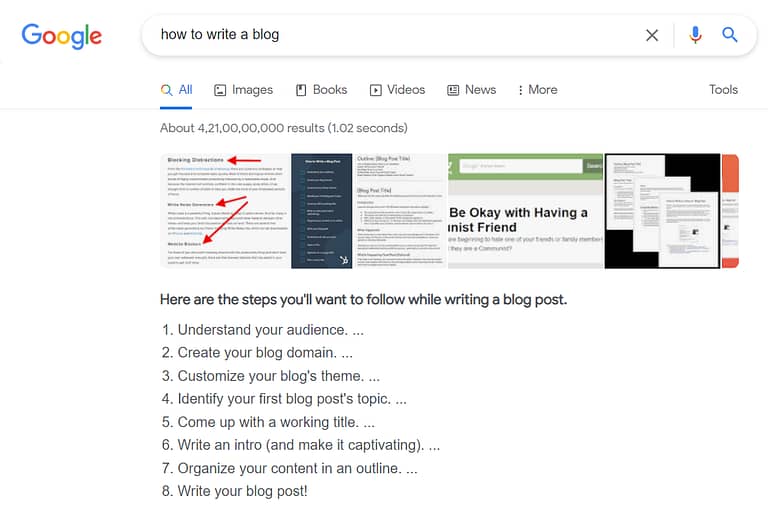Featured Snippets
Featured Snippets
If your site is not getting enough traffic and you find it hard to rank at the top positions, Featured Snippets can make your task easier.
If you want to show up in Google results, you must adapt to all the changes and new features.
Featured Snippets are one so!
These are the results that appear at the ‘zero position.’ They help the users to answer their questions without even clicking. It has immensely enhanced user experience as they no longer need to click the blue URLs on short and practical queries.
Featured snippets show the results extracted from the content on your web page.
You may not be familiar with the terms, but I am sure you must have seen them on Google’s result page.
Let me surprise you with an example!
Let’s see the results for a specific search like “Alfred Hitchcock age”:

I just looked up a straightforward query. Do you think I would have scrolled an inch down onto the ranking pages? Of course not!
It is possible for even a method or process.
Since I write blogs quite often, I searched for the same.

All the key points are available right at one glance. Isn’t it amazing?
But if you notice, the two featured snippets are entirely different from each other. Let us discover few commonly used featured snippets:
Types of Featured Snippets
Paragraph snippets
It answers your question in the text form.

The featured snippet explained the definition, symptoms, and related diseases of vertigo.
I wanted to know which featured snippet ranks first in terms of popularity. Fun fact: another featured snippet appeared to answer my question!
Have a look!

As you can see, my answer got answered right there!
Let us discuss the second most popular featured snippet, Lists.
Lists snippets
When the result comes up with a listing, it’s a List type featured snippet.
It is perfect for explaining a process or ranking in order of preference.
An example of ranking:

It is known as a Bullet List.
Taking another example:

In the result above, my search query “spets for making tea” was process-oriented. So, the listing shown is called the Numbered Listing.
A Numbered List can also be used for essential tips. See this:

Table snippets
It displays the data in tabular form.

Instead of going through the bulky paragraphs, you can get the dimensions from here.
Video
This featured snippet takes you to a video, usually on YouTube.

To avoid any confusion, let us quickly know other parts of SERP:
Knowledge graph:
It is a rectangular box that appears on the right side of SERP. It is a hub of information from various sources like Wikipedia.
It is highly used to answer questions of voice search. It gives you all the key points from past till today of any object, event, or prominent personality.

Rich snippets:

Rich snippets also give bonus information on SERP before a user clicks on the page, like featured snippets.
But, both have a crucial difference between them!
Rich snippets appear between the URL and description of a page’s snippet. It will appear along with the page in its respective position.
Whereas featured snippets only appear at the zero position.
Knowledge card:

Though the information is served right there, it is still not a featured snippet!
Wondering why?
Because it doesn’t come from content any particular web page, just like a knowledge graph.
Entity carousel:
It is a slider row of results that appears in image form. These carousels are usually based on entities.
Their primary source of information is top-ranking pages and knowledge graphs.
It can be for movies, courses, recipes, inventions, etc. They are presented in card form on Google’s SERP.
For example:

One common thing in the above three forms of results is that they don’t come from just one resource, instead of top-ranking pages and knowledge graphs.
Featured Snippet good or bad:
As we talked about earlier, featured snippets are present at the zeroth position on SERP. So, they are the first thing visitors see if their search query supports featured snippets.
Sure, ranking on the first position for a keyword is a challenging task to achieve, but coming in the top positions is not a hard nut to crack.
Almost all featured snippets come from the top 10 ranking web pages.
So, imagine you rank in 7th position for a keyword, but you include a featured snippet, and Google chooses it to show on that keyword results. Boom! You hit the first position on SERP in literally no time.
Now, there can be two sides to it.
As in this case, because your page has jumped from a lower position to a higher one, people will take more notice of it. As per results, the number one result on SERP gets the most number of clicks.
This effect is even more prominent on mobile devices. If a search query has a featured snippet for it, the user would only see that on the entire screen before he scrolls down. It grabs your attention even more.
Good for you.
But, it has one downside too! They click the number of no-click searches. The visitors get their precise answer to the search query right at the top of the results page.
Why would they bother to scroll down when the answer is right at the top?
Knowing this can be very helpful while choosing a keyword. If it already has a featured snippet, the chances are that your page will get fewer clicks.
But that doesn’t mean that you should discard such keywords. After all, 11.84% of search queries will have a featured snippet for them.
Also, it varies from query to query.
Let’s take a previously discussed example again. Remember the steps for washing white clothes?
Here they are:

Here’s the CTR for the keyword:

For the first query, a user still would want to know more about the steps given. Nobody would want to ruin their white piece of cloth, so there are high chances of them going and reading about it in detail on the page.
Therefore, the CTR is high as 64%.
Whereas if I look up for Trump’s age:

Do you see the drop in CTR?
It is because a query like “Trump’s age” is direct and needs no further explanation. When a person looks up this query, they are precise about what they want to know and stick to that.
Hence, the CTR is 36%.
After knowing this, let us quickly know the types of search queries that have high chances of featured snippets:
As I mentioned, around 99% of the featured snippets come from the top 10 ranking pages on SERP. So, if you’ve already made it to this spot, your content has a high chance of giving a featured snippet for that query.
Here are some types of search queries that get the most featured snippets for them-
Processes:
Here’s a straightforward example which we all can relate to:

Health-related queries:

Financial and mathematical queries:
Sometimes, these snippets can also be your answer boxes. Mostly, these are for mathematical and financial queries.
For example:


That is why a featured snippet is also known as Google’s answer box. At times it can be a little confusing to these terminologies straight!
So, let’s stick to featured snippets.
Listings:

These were all main types of queries that have a fair chance of showing featured snippets.
Previous
Next

